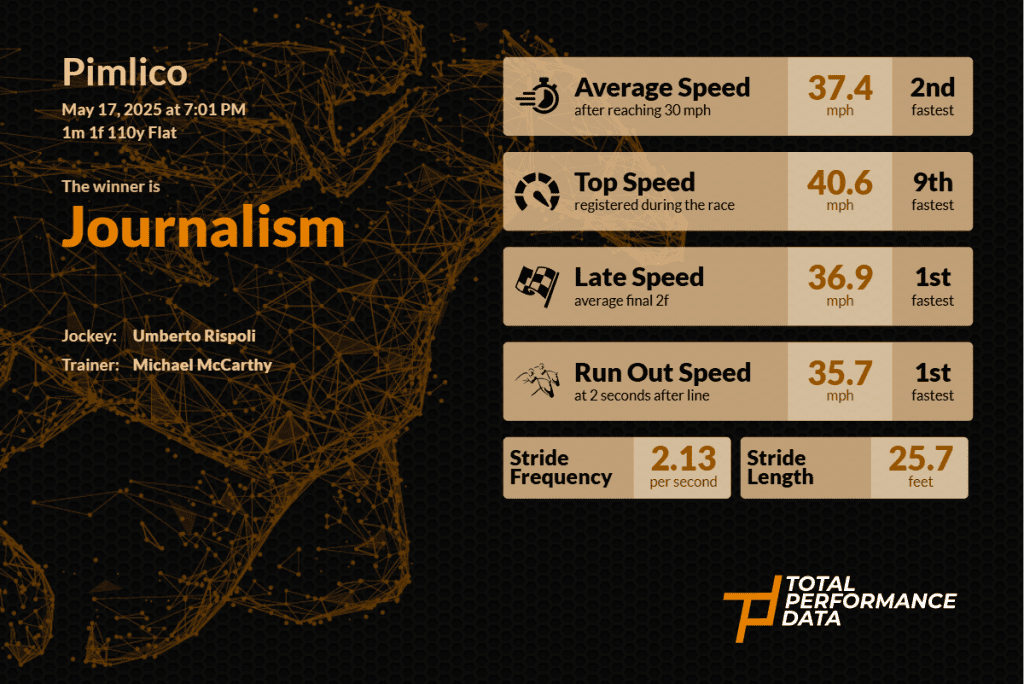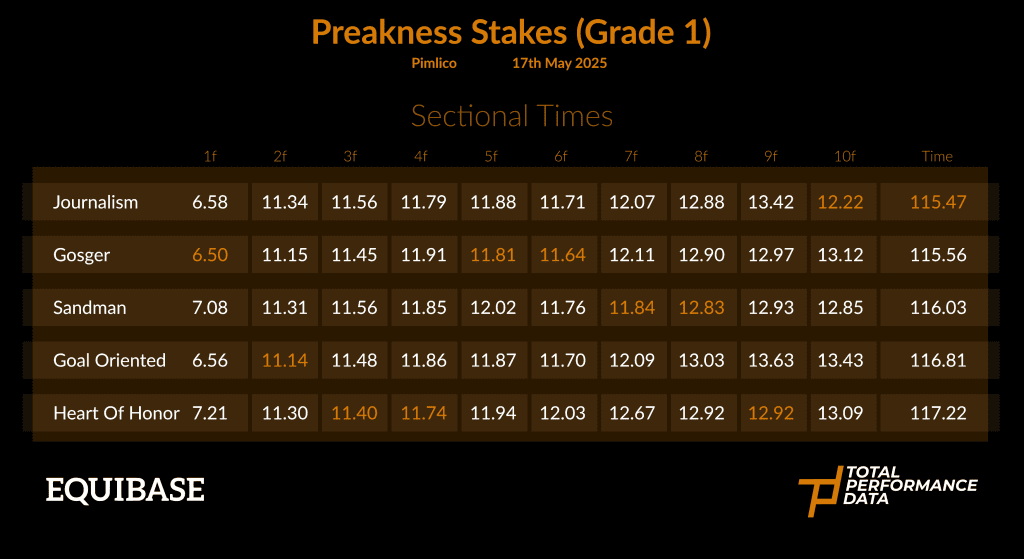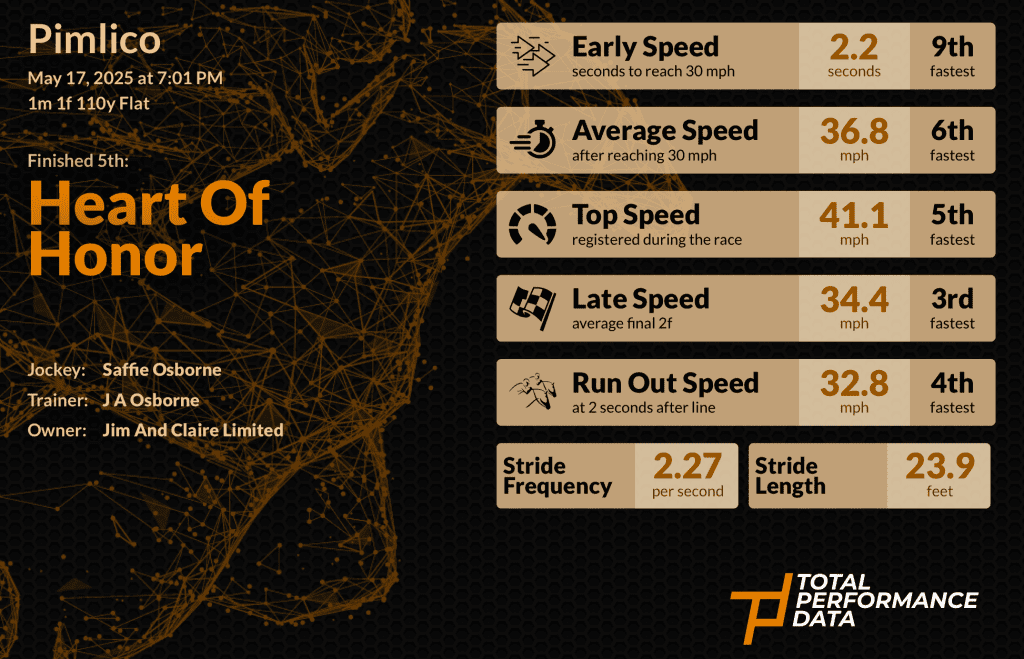How? That’s the best question to ask when trying to review this year’s Preakness Stakes. How did Journalism get there? Rather than focus on the interference in the straight and what might have happened, I have chosen to look at the data which shows the performance of a remarkable horse. With a furlong to run, this race looked all over and the connections of the runner-up, Gosger, can be forgiven for thinking that they had the 150th running of this race in the bag. I’m actually going to start this piece by looking at the runner-up. He came into this race having won the Stonestreet Lexington Stakes at Keeneland in April. That was a Grade 3 contest where he was able to finish strongly, clocking the fastest final furlong in 12.90s and a run-out speed of 32.93 mph. On just his 3rd start, that was a solid performance and suggested that he was going the right way, but the 2nd and 4th were both beaten in Optional Allowance Claimers on their next starts and there was no obvious reason to think that form would be good enough to win a Preakness. However, he did everything right for Luis Saez, breaking well from the widest draw and taking 6.5s to reach the first furlong pole (ranked 2nd) to get into a prominent position. Sent for home as they rounded the final turn he looked the most likely winner for all but the last 50-yards. He was tiring and at the point that Journalism is flying at him, we should consider that his stride frequency has dropped to an average of 2.13 per second and his final furlong time of 13.12s, was slower than the winner, 3rd and 5th placed horses. He has still beaten everything else in the field and is likely to find easier assignments than Journalism in the future. There is no doubt from the data that Gosger has confirmed his credentials as a Grade 1 winner in waiting.


Gosger is a very good horse, but there is every chance that he was beaten by a truly great one. Journalism didn’t look entirely comfortable around the bends at Pimlico and the only time that he ran the fastest furlong split was in the final furlong of the race, but despite all the trouble he met in the closing stages, he got there and that’s what matters. A final furlong of 12.22s at the end of a race run with a finishing speed of 94.6% is remarkable, especially when we consider that the 12.22s he ran at the finish was the fastest individual furlong of any runner in the last 3-furlongs of the race. Even more remarkably, he recorded a run-out speed of 35.68 mph, the best in the field by almost 2 mph, which could suggest that he had more in the locker if he needed it. Umberto Rispoli certainly took him all the way around the bend to pull him up. A top speed of 40.62 mph actually saw Journalism ranked 9th of the 9 runners, but with an average stride length of 25.92 ft, easily the longest in the field, he was able to stretch when it mattered to catch Gosger. His connections will feel that they have their just rewards for a brave effort in the Derby a fortnight ago, where perhaps now the Sloppy track seems to be the only explanation for his defeat and the data from TPD would suggest that this won’t be the last Grade 1 that he adds to his CV this season.


There’s no obvious reason to think that any of this form will be reversed in the future, but there are some important points to be taken from the data for the rest of the field. Sandman has finished 3rd and has finished his race well. A final furlong of 12.85s and a run-out speed of 33.87 mph was only surpassed by Journalism and he has got much closer than he did at Churchill Downs 2-weeks ago. His issue comes at the start of his races. Taking 7.08s to reach the first furlong pole saw him ranked 8th of the 9-runners and he was last as the field headed into the first turn. It was a similar story in the Kentucky Derby, where an opening split of 13.13s saw him ranked 17th and left him with a lot of ground to make up. He is capable of winning a Grade 1 and at an average of 25.46 ft, he had the 2nd longest stride in the field, but he needs to get closer to the pace in the early stages if he is to improve on his 3rd placed finish in the future, especially when we allow for the fact that he had an easier passage in the straight than Journalism did.
Goal Oriented lurched to his left when leaving the stalls and despite recovering well, he wasn’t able to take advantage of his good draw in stall 1 as Clever Again came across to lead. He kept going and on just his 3rd start, this was still a career best performance, but when getting involved in some skirmishing with Journalism in the straight, he didn’t have the pace or the stamina at that stage of the race to hold his position. A final furlong of 13.43s was the slowest of the first 5 horses to cross the line.


Finally I will come to Heart of Honor. Jamie Osborne took a chance to come here and although a 5th placed finish might be seen as a disappointment initially, his connections can hold their heads high after a brave effort. At an average of 24.21 ft, his stride was over 1.5 ft shorter than the winners and having been the slowest horse to reach the opening furlong pole in 7.21s, he had a mountain to climb from the very start. Ridden along by Saffie Osborne, he could have been forgiven had he trailed in last of the 9 runners, but he showed a tremendous attitude to finish his race in furlongs of 12.92 and 13.09s. We need to allow for the fact that Journalism was short of room at a crucial stage, but the 12.92s penultimate furlong was the fastest in the field from Heart of Honor. The strong early pace looked to catch him out and the track at Pimlico is far less suitable for a strong finisher like him than it is at Meydan. However, he showed a lot more promise here than Admire Daytona did in the Kentucky Derby at the start of the month and over the final 3-furlongs he was only 0.41s slower than Journalism. A fine performance.